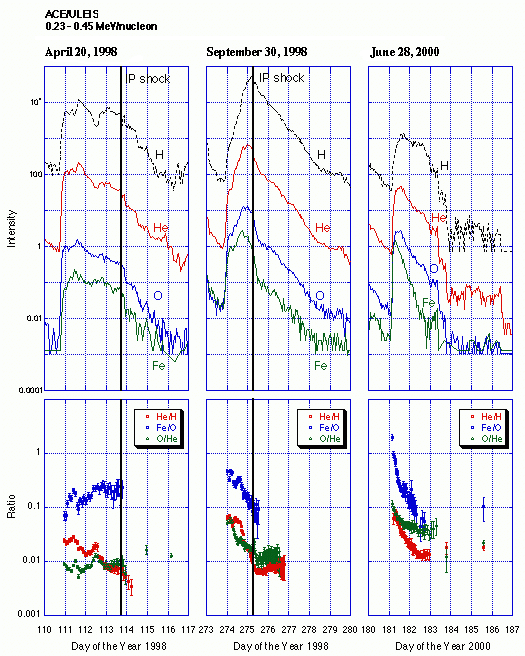
| ACE News Archives | ACE News #59 (revised)- February 15, 2002 |
ACE News Archives |
| ACE Science Nuggets |
|
ACE Science Nuggets |

Some years ago Mason et al. (ApJ, vol. 267, 844,1983) reported that during the onset of large, well-connected SEP events, the Fe/O, O/He, and He/H ratios showed large temporal changes that in most, but not all, cases could be understood as an interplanetary propagation effect caused by the scattering mean free path increasing with particle rigidity. Recently, Ng, Reames and Tylka (GRL, vol. 26, 2145, 1999) explored another approach to these onset-phase abundance variations by modeling the effects that proton-generated Alfven waves would have on the scattering of SEP ions during propagation from the acceleration region to the observer. This rigidity dependent scattering can also modify the abundance ratio of species even when they have the same velocity. In particular, the latter theory predicts an initial decrease in both the He/H and Fe/O ratios at energies >2 MeV/nucleon during large SEP events.
Investigators on both ACE and Wind spacecraft have shown that ion composition variations observed in a few large SEP events at the higher energies (>2 MeV/nucleon) qualitatively agree with these rigidity dependent transport models. However, the same type of variation has not been studied systematically at lower energies, and we present here initial results of such a study.
In the figure above, we show the low energy (~500 keV/nucleon) abundance ratio of He/H, Fe/O and O/He measured by ACE ULEIS during three large SEP events. These events all come from close to the west limb of the Sun. We thus attempt to minimize effects of magnetic connection. All three events exhibited a decrease in the He/H ratio as suggested by the wave-particle model, but the degree of variation of He/H varies from event to event. In the April 1998 event (DOY 110), the Fe/O ratio even increases within the event. It appears that in two of the three cases studied the expected effects of Alfven waves are indeed observed, while in the April 1998 event the observed variations differ somewhat from the expected pattern.
Contributed by George Ho and Edmond Roelof of the Johns Hopkins University Applied Physics Laboratory , and Glenn Mason of the University of Maryland. We acknowledge the help of Hillary Cane with SEP event associations.
Last modified 15 February 2002, by
Andrew Davis